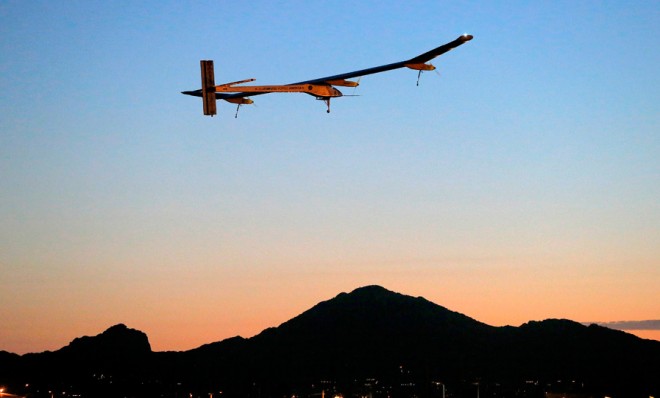What Solar Impulse's under-the-radar flight says about the future of solar energy
The journey was slow, but successful, and the creators of the aircraft believe they've demonstrated the possibilities of solar energy — on the ground

On May 3, the Solar Impulse, a conspicuously lanky solar-powered aircraft created at the Swiss Federal Institute of Technology in Lausanne, lifted off the runway at the Moffett Airfield near San Francisco to fanfare and international media attention. Forty-five days later, on June 16, it concluded its expedition, delivering its pilots safely to Dulles International Airport in Washington D.C. — an event which likely flew entirely under your radar, says The Washington Post's Dominic Basulto.
To be fair, the Solar Impulse isn't a spectacle like a rocket ship, or even the new Airbus "Flossie." Though it has the wingspan of a jumbo jet, the whole craft weighs 3,500 pounds — about as much as a small car — and can support just a tiny two-seat cockpit with no amenities, not even plumbing. Each seat is "like a really bad economy seat on an airliner," Gregory Blatt, a managing director of the company, told The New York Times.
And it doesn't exactly whiz through the air, either. Its 12,000 photovoltaic cells push the craft to an average cruising speed of just 44 mph. For an idea of what such a speed looks like on an airplane, see this video of the Solar Impulse landing in Cincinnati:
The Week
Escape your echo chamber. Get the facts behind the news, plus analysis from multiple perspectives.

Sign up for The Week's Free Newsletters
From our morning news briefing to a weekly Good News Newsletter, get the best of The Week delivered directly to your inbox.
From our morning news briefing to a weekly Good News Newsletter, get the best of The Week delivered directly to your inbox.

But the Solar Impulse was not built with the future of commercial solar air travel in mind. Those involved insist that the project is largely symbolic, an opportunity to show the possibilities of solar energy.
"On the ground, the potential is huge and is readily available," Solar Impulse CEO Andre Borschberg told The Associated Press.
Ernest Moniz, the head of the Department of Energy, agreed that the plane probably won't change the way we fly — but that it could impact the way we drive, build buildings, and power appliances.
Another possible angle for what the Solar Impulse's 45-day journey could symbolize: How long it is taking to fund, develop, and start using solar technology. The first photoelectric cell was built in 1888 by Russian physicist Aleksandr Stoletov. Only now (under the pressure of climate change and oil scarcity) are we transforming it into a viable energy source.
A free daily email with the biggest news stories of the day – and the best features from TheWeek.com
Which isn't to say solar use isn't accelerating. The first quarter of 2013 was the biggest ever for the industry: Across the U.S., 723 megawatts of solar power were installed, bringing the total to 7,962 megawatts. For context, one megawatt of power can sustain about 1,000 homes for one hour. We may even be on the cusp of a solar boom.
But Basulto thinks the enthusiasm gap between the time of Solar Impulse's take-off in California and its landing in Washington, D.C., might say something about our collective attention span when it comes to renewable energy:
Solar Impulse's journey, in many ways, is a microcosm of our nation's love/hate relationship with renewable energy. We love the promise of clean energy and celebrate the arrival of the latest green gizmos, but we have very little patience for renewable energy strategies that take years, if not decades, to pay off. Our ability to embrace the journey of a zero-fuel airplane over a sustained, 45-day flight from San Francisco to Washington offers a gut-check: Are we, as a nation, able to sustain the march to a zero-fuel economy. [Washington Post]
Still, the Solar Impulse team isn't letting up. "The plane's designers say the successor airplane, already under development, needs crucial but incremental improvements," says the Times. The next version will have plumbing, and each seat "will be like a good business-class seat." That craft will hopefully be used by 2015 for a journey around the world. In the meantime, perhaps solar energy on the ground can catch up.
Carmel Lobello is the business editor at TheWeek.com. Previously, she was an editor at DeathandTaxesMag.com.
-
 Received a gift card this holiday season? Here’s how to maximize it.
Received a gift card this holiday season? Here’s how to maximize it.The Explainer Make the most of your present
-
 ‘Lumpy skin’ protests intensify across France as farmers fight cull
‘Lumpy skin’ protests intensify across France as farmers fight cullIN THE SPOTLIGHT A bovine outbreak coupled with ongoing governmental frustrations is causing major problems for French civil society
-
 The best books of 2025
The best books of 2025The Week Recommends A deep dive into the site of a mass shooting, a new release from the author of ‘Atonement’ and more